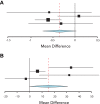Meta-Analysis: The Clinical Application of Autologous Adult Stem Cells in the Treatment of Stroke
- PMID: 35002259
- PMCID: PMC8721025
- DOI: 10.2147/SCCAA.S344943
Meta-Analysis: The Clinical Application of Autologous Adult Stem Cells in the Treatment of Stroke
Abstract
Introduction: Stroke is a leading cause of death and disability worldwide. The disease is caused by reduced blood flow into the brain resulting in the sudden death of neurons. Limited spontaneous recovery might occur after stroke or brain injury, stem cell-based therapies have been used to promote these processes as there are no drugs currently on the market to promote brain recovery or neurogenesis. Adult stem cells (ASCs) have shown the ability of differentiation and regeneration and are well studied in literature. ASCs have also demonstrated safety in clinical application and, therefore, are currently being investigated as a promising alternative intervention for the treatment of stroke.
Methods: Eleven studies have been systematically selected and reviewed to determine if autologous adult stem cells are effective in the treatment of stroke. Collectively, 368 patients were enrolled across the 11 trials, out of which 195 received stem cell transplantation and 173 served as control. Using data collected from the clinical outcomes, a broad comparison and a meta-analysis were conducted by comparing studies that followed a similar study design.
Results: Improvement in patients' clinical outcomes was observed. However, the overall results showed no clinical significance in patients transplanted with stem cells than the control population.
Conclusion: Most of the trials were early phase studies that focused on safety rather than efficacy. Stem cells have demonstrated breakthrough results in the field of regenerative medicine. Therefore, study design could be improved in the future by enrolling a larger patient population and focusing more on localized delivery rather than intravenous transplantation. Trials should also introduce a more standardized method of analyzing and reporting clinical outcomes to achieve a better comparable outcome and possibly recognize the full potential that these cells have to offer.
Keywords: adult stem cells; autologous; clinical application; inflammation; meta-analysis; neurogenesis; stroke; stroke recovery; systematic review.
© 2021 Hassani et al.
Conflict of interest statement
We declare there is no conflict of interest.
Figures





Similar articles
-
The future of Cochrane Neonatal.Early Hum Dev. 2020 Nov;150:105191. doi: 10.1016/j.earlhumdev.2020.105191. Epub 2020 Sep 12. Early Hum Dev. 2020. PMID: 33036834
-
Trial design and reporting standards for intra-arterial cerebral thrombolysis for acute ischemic stroke.Stroke. 2003 Aug;34(8):e109-37. doi: 10.1161/01.STR.0000082721.62796.09. Epub 2003 Jul 17. Stroke. 2003. PMID: 12869717
-
Limbal stem cell transplantation: an evidence-based analysis.Ont Health Technol Assess Ser. 2008;8(7):1-58. Epub 2008 Oct 1. Ont Health Technol Assess Ser. 2008. PMID: 23074512 Free PMC article.
-
Stem cell therapy: a new hope for stroke and traumatic brain injury recovery and the challenge for rural minorities in South Carolina.Front Neurol. 2024 Aug 9;15:1419867. doi: 10.3389/fneur.2024.1419867. eCollection 2024. Front Neurol. 2024. PMID: 39184380 Free PMC article. Review.
-
Stem cells in stroke repair: current success and future prospects.CNS Neurol Disord Drug Targets. 2011 Sep 1;10(6):741-56. doi: 10.2174/187152711797247894. CNS Neurol Disord Drug Targets. 2011. PMID: 21838668 Review.
Cited by
-
In Vitro Study of a Novel Vibrio alginolyticus-Based Collagenase for Future Medical Application.Cells. 2023 Aug 8;12(16):2025. doi: 10.3390/cells12162025. Cells. 2023. PMID: 37626834 Free PMC article.
-
Pilot Study for Isolation of Stromal Vascular Fraction with Collagenase Using an Automated Processing System.Int J Mol Sci. 2024 Jun 28;25(13):7148. doi: 10.3390/ijms25137148. Int J Mol Sci. 2024. PMID: 39000252 Free PMC article.
-
Stem Cells Attenuate the Inflammation Crosstalk Between Ischemic Stroke and Multiple Sclerosis: A Review.Cell Transplant. 2023 Jan-Dec;32:9636897231184596. doi: 10.1177/09636897231184596. Cell Transplant. 2023. PMID: 37515536 Free PMC article. Review.
References
-
- Donnan G, Fisher M, Maclead M, Davis S. Stroke. Lancet. 2008;373(9674):1496. doi:10.1016/S0140-6736(09)60833-3 - DOI
Publication types
LinkOut - more resources
Full Text Sources

